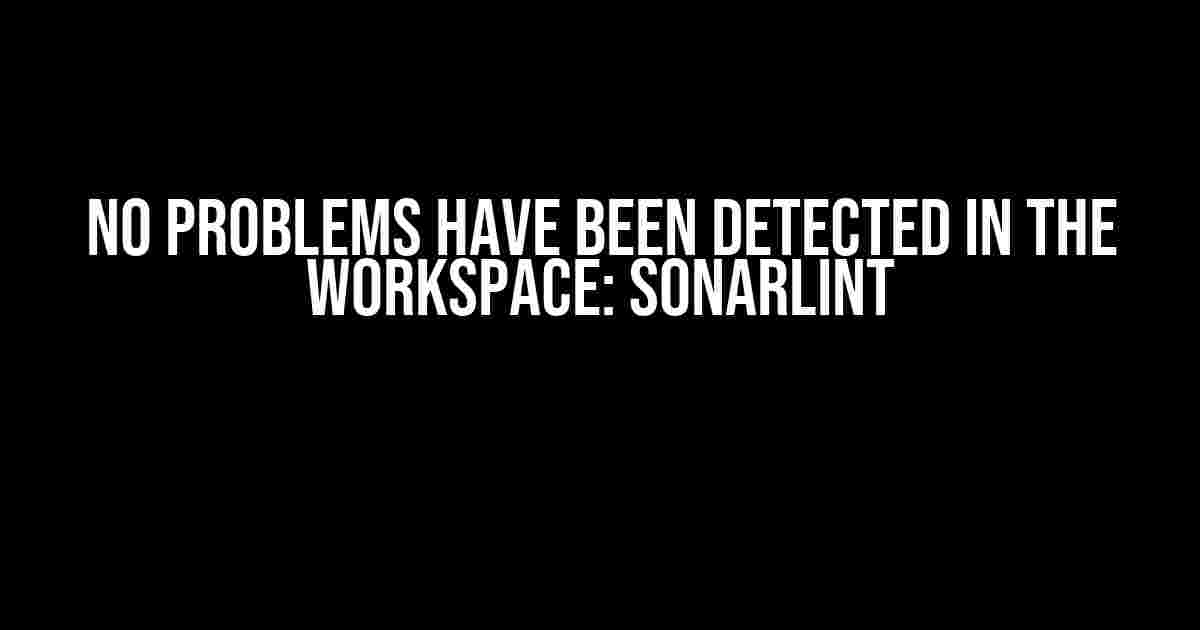Ah, the sweet feeling of seeing that message pop up in your IDE: “No problems have been detected in the workspace: SonarLint”. It’s like a badge of honor, a sign that your code is clean, efficient, and ready to take on the world. But, have you ever wondered what exactly SonarLint is, and how it’s able to give you that peace of mind? In this article, we’ll dive into the world of SonarLint, exploring its features, benefits, and how to get the most out of this powerful tool.
What is SonarLint?
SonarLint is a free, open-source tool developed by SonarSource, a leader in code quality and security. It’s an Integrated Development Environment (IDE) extension that provides real-time feedback on your code, identifying bugs, vulnerabilities, and code smells. SonarLint supports a wide range of programming languages, including Java, C#, Python, and many more.
How does SonarLint work?
SonarLint uses a combination of algorithms and machine learning to analyze your code as you write it. It checks for a wide range of issues, including:
- Syntax errors and typos
- Security vulnerabilities, such as SQL injection and cross-site scripting
- Code smells, like duplicated code and long methods
- Performance issues, including inefficient algorithms and memory leaks
- Code style and formatting inconsistencies
When SonarLint detects an issue, it provides a clear and concise message, along with suggestions for how to fix the problem. This feedback is provided in real-time, as you type, allowing you to catch and fix errors before they become major problems.
Benefits of using SonarLint
So, why should you use SonarLint? Here are just a few benefits of incorporating this powerful tool into your development workflow:
- Faster development: With SonarLint, you can catch and fix errors as you code, reducing the time spent on debugging and rework.
- Improved code quality: SonarLint helps you write cleaner, more efficient code, reducing the risk of bugs and vulnerabilities.
- Enhanced security: SonarLint’s security features help you identify and fix vulnerabilities, protecting your application and users from potential threats.
- Better collaboration: SonarLint’s real-time feedback helps team members working on the same project to catch and fix errors, improving overall code quality and consistency.
Setting up SonarLint in your IDE
Getting started with SonarLint is easy. Here’s a step-by-step guide to setting up SonarLint in your IDE:
- Download and install: Head to the SonarLint website and download the appropriate plugin for your IDE (e.g., Eclipse, IntelliJ, Visual Studio).
- Configure SonarLint: Once installed, configure SonarLint by setting up your project and specifying the languages and rules you want to use.
- Start coding: With SonarLint enabled, start coding as usual. SonarLint will provide real-time feedback on your code, highlighting issues and suggesting fixes.
SonarLint Configuration Options
SonarLint provides a range of configuration options, allowing you to customize the tool to fit your needs. Some key options include:
| Option | Description |
|---|---|
| Rules | Specify which rules you want to enable or disable, including syntax errors, security vulnerabilities, and code smells. |
| Languages | Choose which programming languages you want SonarLint to analyze. |
| .project file | Configure SonarLint to use a specific .project file, which defines the project structure and settings. |
Troubleshooting SonarLint Issues
Sometimes, SonarLint may throw an error or false positive. Don’t worry, we’ve got you covered. Here are some common issues and their solutions:
If SonarLint is reporting a false positive, you can:
- Suppress the issue: Use the
@SuppressWarningsannotation to suppress the issue. - Configure the rule: Adjust the rule configuration to reduce false positives.
- Report the issue: Submit a bug report to SonarLint’s GitHub page.
Error Messages
If SonarLint is displaying an error message, try:
- Checking the error message: Read the error message carefully to understand the issue.
- Verifying your code: Check your code for syntax errors or inconsistencies.
- Restarting your IDE: Sometimes, a simple restart can resolve the issue.
- Reporting the issue: Submit a bug report to SonarLint’s GitHub page.
Conclusion
Happy coding!
Frequently Asked Questions
Got questions about “No problems have been detected in the workspace: SonarLint”? We’ve got you covered!
What does “No problems have been detected in the workspace: SonarLint” even mean?
This message is music to your ears! It means that SonarLint, a code analysis tool, has scanned your code and didn’t find any issues or problems that need attention. You’re good to go!
How does SonarLint detect problems in my code?
SonarLint uses a set of rules and algorithms to analyze your code and identify potential issues, such as bugs, security vulnerabilities, and code smells. It’s like having a super sharp code reviewer built into your development environment!
What if I’m not using SonarLint? Can I still get this message?
Nope! This message is specific to SonarLint, so you won’t see it if you’re not using the tool. However, it’s worth noting that other code analysis tools might have similar messages or indicators when they don’t find any issues.
Is “No problems have been detected in the workspace: SonarLint” a guarantee that my code is perfect?
Not quite! While SonarLint is an amazing tool, it’s not infallible. It’s possible that it might miss some issues or false positives. It’s still important to manually review your code and test it thoroughly.
How often does SonarLint scan my code for problems?
SonarLint typically scans your code in real-time, as you write it. This means that you’ll get instant feedback on any potential issues. Of course, you can always configure SonarLint to scan your code on demand or at specific intervals, depending on your preferences!

